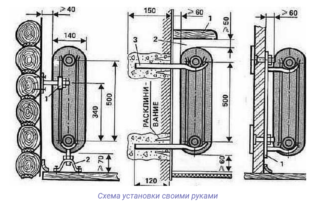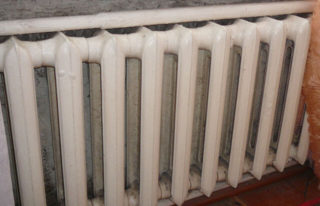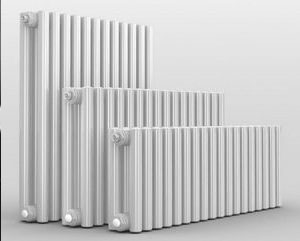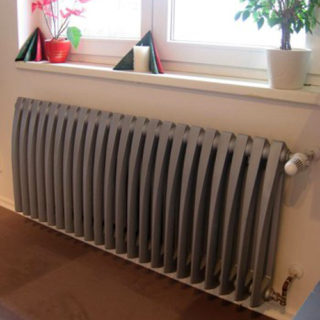Heating batteries made of cast iron have been known since Soviet times and still do not lose their relevance. More popular are models made of non-ferrous metals, for example, aluminum or steel, which are noticeably superior to cast-iron counterparts in a number of parameters. Nevertheless, classic cast-iron batteries are in demand and are present in many houses and apartments. They have their pros and cons, as well as characteristic features that should be considered when choosing a material.
Advantages and disadvantages of cast iron radiators
Standard batteries of the old model are characterized by increased heat dissipation, which is absent in analogues made of other materials. For this reason, they are still being used to heat residential premises. Their main feature is the ability to evenly warm the room and keep warm for a long time. Modern cast-iron radiators are able to fit into any interior thanks to a large selection of models. In the assortment that the manufacturers offer, you can find options with screens and a reduced number of sections. The list of pluses also includes:
- maximum service life - up to 50 years;
- resistance to corrosion and technical damage;
- optimal distance between axles - 500 mm;
- the ability to install electric heating elements for thermoregulation and additional heating.
The cast-iron Russian radiators have their drawbacks: the design is not very attractive and the batteries are old, the installation problems and the likelihood of manufacturing defects. Cast iron is not able to tolerate sudden surges in pressure in the heating system; it is often depressurized in the joints. Batteries are difficult to clean from dust and dirt, many old-type samples have an inconvenient rough coating, which is absent in newer counterparts.
Technical and operational specifications
To choose a suitable cast iron radiator, you need to take into account the technical characteristics of batteries of this type. The main parameter is the level of heat transfer, depending on the area of the room in which it is necessary to install radiators. Additional important criteria include equipment weight, height, width and depth parameters, as well as heat output.
Most often, radiators with a working pressure of not more than 6 atmospheres are installed in apartments and private houses. To accurately determine the power, you need to take into account the number of windows and external walls in the room, as well as calculate the number of battery sections and know how many kW one section allocates.
Varieties of cast iron batteries
By construction, such batteries can be compared with the designer, since they are composed using sections of the same type. Cast iron central heating batteries are made of gray cast iron, the water channels in them are usually in the form of a circle or ellipse, and gaskets made of rubber or paronite are additionally placed inside them.
According to the number of channels, radiators can be single-channel or two-channel, have different widths and heights, depending on the number of sections. The width parameter is also affected by the area of the room, the number of windows and wall thickness.
The more sections in the battery, the better it is able to warm the room, so it is important to accurately calculate the parameters of the room before installing such radiators. The height of the equipment usually ranges from 35-150 cm, depth - 50-140 cm.Depends directly on the depth of how accurately the battery will fit into the overall interior of the room.
On sale you can find models of floor and wall type. The former are fixed using special brackets, the latter are supplemented by installation supports or “legs”.
Modern radiators
There are many good new generation radiators available in stores. The batteries are made of Euro cast iron and feature an innovative design. The most popular were models with a flat surface and special screens. Batteries from different manufacturers have their own characteristics, which you should pay attention to when buying a radiator for your home or apartment.
Turkish
Practical Turkish radiators from the Demrad Ridem brand are equipped with two, three or four channels. Their working and test pressures are 10 and 15 bar, respectively. They have a primed surface that can be designed of your choice.
Czech
Among Czech batteries, the most famous models are from the Viadrus STYL company, which belong to the radiators of a new type and come in several versions. In models of factory assembly of at least 10 sections, customers can choose one of the options: primed or coated with white enamel. Radiators of this brand are known for their non-standard and stylish shape, optimal degree of heat transfer and compact size.
Belarusian
Belarusian two-channel radiators of the 2K60PP model have a flat surface, a smooth front panel, machined. They well complement the interior of a modern room and significantly increase heat transfer. Factory copies are supplied in standard primer treatment and can be supplemented with installation “legs”.
Other manufacturers
Demand among buyers are German batteries from the brands Guratec and Kon or Konner, the Spanish brand Roca, as well as the Russian company STI. Such batteries are innovative and expensive, but have much more advantages compared to more budget counterparts.
Cast iron radiators made at factories in Moscow or Lugansk are more often installed in Russia.
Calculation of the required amount
 The easiest way to calculate the amount of heat based on the area of the room in which you want to install batteries. Since the area of the room is already known in advance, it remains to calculate the parameters of heat demand taking into account building norms of SNiPa. In the average climatic zone, for heating 1 m2 of a room, at least 60-100 kW is needed, in areas with temperatures below 60 degrees - 150-200 kW.
The easiest way to calculate the amount of heat based on the area of the room in which you want to install batteries. Since the area of the room is already known in advance, it remains to calculate the parameters of heat demand taking into account building norms of SNiPa. In the average climatic zone, for heating 1 m2 of a room, at least 60-100 kW is needed, in areas with temperatures below 60 degrees - 150-200 kW.
The calculation is carried out according to the formula. For example, if the room area is 16 m2, it needs 16 * 100 = 1600 kW of heat. This is the average norm for regions with frequently changing weather conditions.
Mounting Features
 You can install the cast iron heating radiator in a private house on your own if you have installation skills, but it is better to entrust this work to professionals in the apartment. Batteries installed in multi-storey buildings are capable of creating emergency situations, for example, due to coolant leakage.
You can install the cast iron heating radiator in a private house on your own if you have installation skills, but it is better to entrust this work to professionals in the apartment. Batteries installed in multi-storey buildings are capable of creating emergency situations, for example, due to coolant leakage.
When installing batteries of any type, the norms of SNiP under the number 41-01-2003 from the section on heating, ventilation and air conditioning must be observed. The height from the radiator to the floor can not be less than 10 cm, to the wall - 3-5 cm, to each window sill - from 5 cm.
Radiators should have a length of at least 50-75% of the total width of the window under which they are installed. It is also recommended to check the coincidence of the central axis of the battery with the same axis of the window, the permitted deviation is not more than 20 mm.
The cast-iron battery should be located in a place with good air circulation, for example, under a window or near a door.
If there is a heat-reflecting screen, the distance from the radiator to the wall can be reduced by 2.5 cm. The screens are supplemented with a layer of foil that repels heat from the wall, which allows more warm air.






